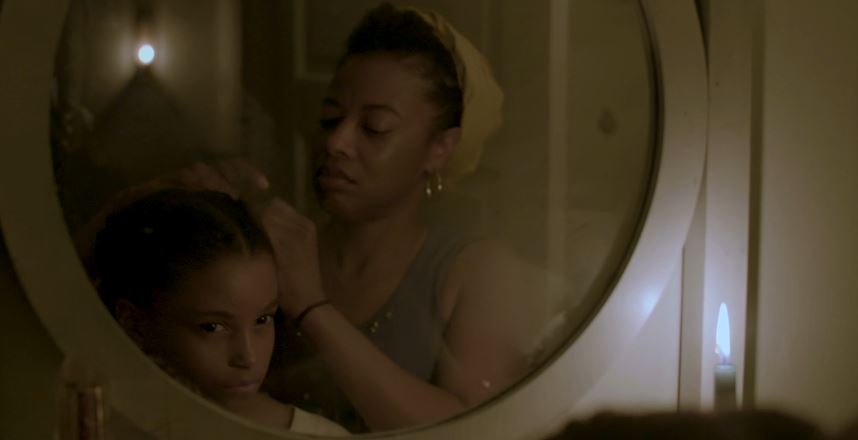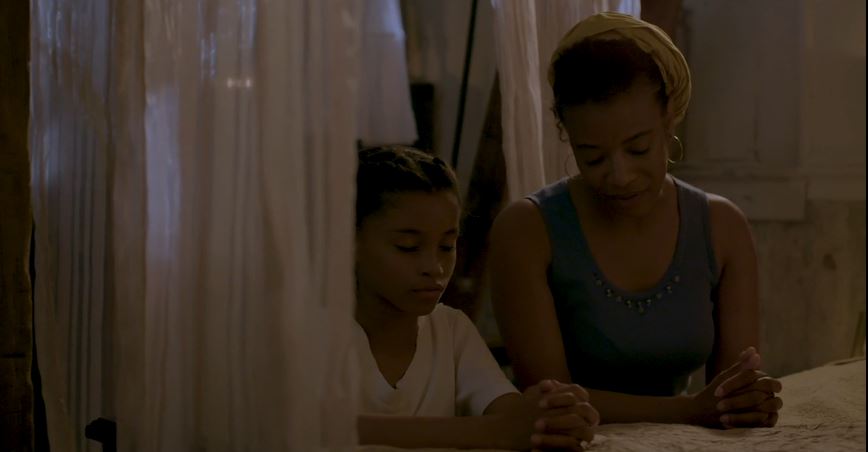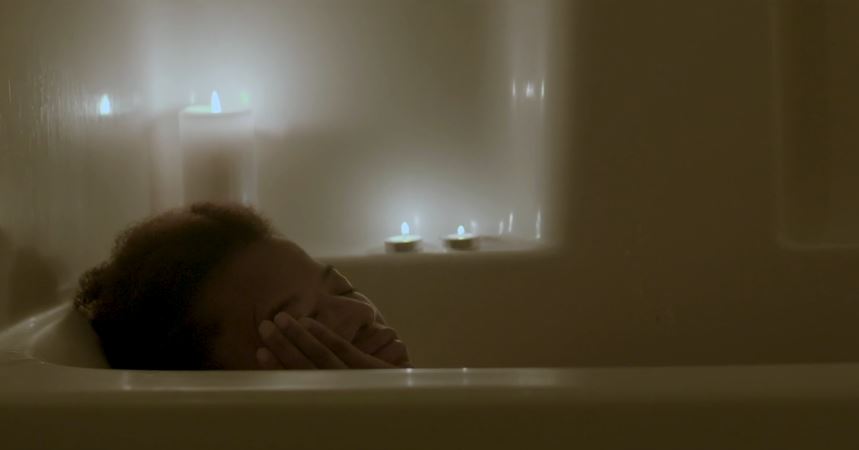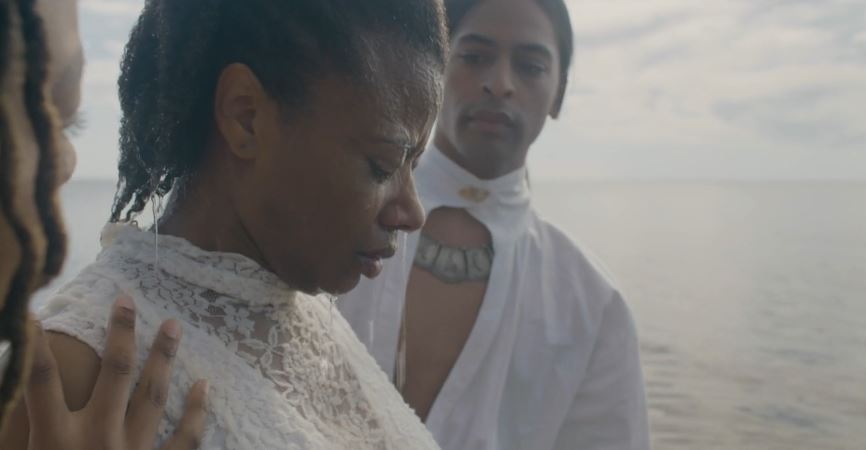‘Blood Runs Down’: Using Rituals in Cinema About Blackness and Womanhood
Full Moon Knight Trailer (Batman vs MK?); Boba Fett; Whedon Unravels & Ray Fisher’s Commentary; The Boys Animated Spinoff; Jamilah Lemieux on Black Men & Chappelle; Chuck D Hip-Hop Doc @PBS; FL "White Discomfort" Bill?-Mid Week in Review Airs WED 8pm EST
February 5, 2022Rodney Barnes and Snoop Dogg Release Graphic Novel ‘Tales From The Crip’
February 6, 2022‘Blood Runs Down’: Using Rituals in Cinema About Blackness and Womanhood
https://blacknerdproblems.com/blood-runs-down-using-rituals-in-cinema-about-blackness-and-womanhood/
A film that stands as a deliciously horror genre short and also a piece of cinema that speaks to Black motherhood and Black girlhood, Blood Runs Down is an exceptional film that has haunted me since I first watched it two years ago. Written & directed by Zandashé Brown, a Louisiana native, the film’s synopsis tells us that “when a woman undergoes a frightening transition, her vigilant five year old daughter must decide between saving her or protecting herself in this haunting tale of inheritance, daughterhood, and demons.”
Here, I wanted to take a closer look at the rituals seen in the film that touch on the complexities of presenting Black and female on screen and the rituals that center us, save us, and stay in our memories against a Southern, supernatural backdrop.
Ritual: Hair Braiding
In the first act of the film marked by the ‘IDOLATRY’ title slide, we learn that young Ana (Farrah Martin) has a birthday coming up – the next day in fact. Here on the eve of her birthday, she’s seated at the beginning of the film in front of a mirror. How this scene is framed proves to be an intimate one to begin this story: Ana’s mother, Elise (Idella Johnson) is patiently working through her hair, one plait already finished. Mom is going through playful banter with her daughter on what she may or may not be able to do as a new birthday is upon her. It is quite a scene with the complexities of Black hair and how this is a sort of ritual that carries weight for Black girls and women everywhere.
Being cared for, being attended to, having love poured into you by way of another Black woman being your mother or a stand-in for her is a cherished experience for many but understandably not all. It is an understated experience that too many non-Black creatives don’t get right on the page or the screen. Here in the muted light in a house that looks like one my grandparents owned, one that my mother grew up in, feels familiar. Not quite like home for me but close. This first scene establishes our characters in the film, their relationship, and the scene of what’s to come: good and bad. The background noise which appears to be the audio of a stand-alone radio fades out as instrumental music slides in with a streaky stringed instrument filling the space straddling me and the title screen appears.
Ritual: Night-time Prayers
In the next scene, Ana and her mother are found in the bedroom of the little girl praying. The camera rolls around just as they pray the Lord’s Prayer. In hushed tones, they are kneeling by the bed, both with hands grasped together. Ana’s eyes remain closed and her mother’s open as she observes her child and guides her through the prayer, affectionately. Another every day, small ritual that carries weight, one that speaks to spirituality. Prayers are very often ways to ensure and ask for protection, guidance, and assurance.
Found in the Holy Bible, the Lord’s Prayer is a simple set of words, so simple it is often used to teach young children in the Christian faith. That simplicity is emphasized by Christ, as he mentions in the book of Matthew, in the sixth chapter in the thirteen verse (Matthew 6:5-13) that followers of Christ should turn to God, their father in prayer like children. They should act as a child would to their earthly father to ask for their needs to be met.
Most often used as a nighttime prayer before bed, it can be remembered as a cherished or hated tradition that parents would take part of, or those with siblings, as an end of day practice. It is important to note that prayer brings along the transformation of the mother. We next see Elise in the mirror alone with a somber face, her expression almost grim, and the audio of the last lines of the last part of the prayer echo in the background. There’s a quick cut out to her turning on the faucet in the bathroom to draw herself a bath before the audience is greeted with her daughter in bed, again unable to sleep playing with dolls.
Ritual: Bathing
Surrounded by candles in the bathtub, Elise lays in the water, naked, head uncovered. She seems to struggle to relax as time goes on. A piano is added to the film’s soundtrack, adding to the stringed instrument, making the musical piece strumming at a pace that almost seems to be steeping, that feels like something is cooking. Something is being stirred up. Something, surely, is happening. Bathing is a sort of restorative ritual done at different times of day, but it is very often left for the evening, the end of day. To wash away the day’s dirt and woes and to prepare for bed and the next day’s tasks. Reclaimed in recent years as self-care, it can and has been touted as a healing and practical, inexpensive way to calm one’s mind and steal away some alone time.
For mothers and female-presenting and identifying people who are parents everywhere, taking a bath (alone) without the presence of their children is affectionately joked about in many circles, my family included, as a way to escape your family and be alone. While Elise is in the tub, the camera cuts away to Ana in a room, twirling around the beautiful white dress that her mother has bought her. A look at a framed photo of Ana as a baby with her mother shows that the faces are now distorted, troubling, and absolutely foreboding of what is to come. It is here while Elise tries to relax that she is greeted by something…some unknown presence.
With the water comes the dark Black presence that creeps upon the mother. The audience is only given a glimpse of a black mass floating as we see Elise’s face alarmed. In the second act of the film marked by the “Resentment’ slide, young Ana creeps into the night, unable to sleep most likely due to excitement and tries on the birthday dress that she asked about. Yes, the very one that her mother told her that she couldn’t see or touch until the next day.
While admiring it twirling around, she falls and tears a small section in the front of the dress…her mother appears. The change is startling. Ana looks stunned and mumbles out apologies and does her best to explain herself, stumbling over her words. A quiet tension is building as the two continue to interact with Elise sitting down to smoke, something unlike her, as her daughter observes with a “You don’t smoke.” She’s agitated, looks exhausted, and starts to rage when asked if she’s okay. It is then that fear starts to dawn on Ana’s face when her mother picks up scissors, points them at her, and then shreds a section of the front of Ana’s birthday dress.
When she leaves the room, young Ana immediately runs to the telephone and tries to dial a number to presumably call for help, but she is greeted by a strange, distorted voice and hangs up. She then looks around as if her senses are finally tuning in that something is amiss, and her mother is caught up in it. Shadows appear on the walls to Ana. Elise rubs her eyes in the bathroom mirror, seeing someone who is not there presently, which leads to Ana finding her mother in the bathroom with eyes that seem to drip or cry red blood. This frightens the girl, and she runs for the sanctuary that is her bedroom where she locks the door and looks to fend for herself as her mother repeatedly bangs on the door with a voice that is easily distorted and in terrible agony.
Ritual: Baptism
It is in the next scene that Elise in the bath where she looks more serene and more like her old self. Once again emerged in water, she’s quiet and speaking in a more controlled tone. In the third act of the film marked by the “GRIEF,” Elise in the tub is what looks like a scene before the terrible transformation began, and Ana is not in the birthday dress, but her nightgown. Ana cannot sleep, and her mother shares one of the ways that aids her to dream land: she ponders on her life and the events that already took place, what if she did something different, and what she will do in the future. There are many things left unsaid in the air of mother and daughter here in this shared space. The camera is focused on Elise and the many expressions that flit through her eyes. She is emotional as her eyes tear up a bit.
Is Elise thinking about her life before Ana entered her life, perhaps a career or lifestyle before motherhood? Perhaps she is thinking of Ana’s father, as he does not seem present in the house–not in the framed photo of the two, not in any possessions lying around the house that may belong to a man? In the midst of this, Elise is started by the beeping alarm of a nearby digital clock or perhaps a radio that reads 12:00. It is the new day. It is Ana’s birthday, and her mother tells her so and adds in that she loves her, tearfully. Ana dutifully tells Elise that she loves her too, along with apologizing as she places her hands on her mother in what I can only assume is to push her down into the water. Then a blue and white sky meets Elise along with the two strangers she was in the vision earlier, she is lifted up out of the water elsewhere – out of her house and during daytime, clothed in a white dress.
Elise has seemingly been baptized. In the Christian faith, being baptized is a traditional rite of passage and admission using water, most often being immersed in a body of it. It signifies rebirth and a sort of adoption into the body of Christ, his family, and a church’s or organization’s congregation or gathering. Many of the faith consider it as a person’s sins being washed away and a rebirth of that person from their old ways. A transformation for some, symbolically. Elise wakes up in this new way, in white clothing, laughing and looking freer than she’s ever looked in the film with the two strangers calmly and lovingly holding her. In the very next scene, Ana is alone; her mother and the water gone.
An older woman approaches and tells the little girl that her mother is not coming back, after she tells her that her mother has visited her again. Shocked, I pause, scrambling to put together the chain of events that happened, wondering if I got them out of place. Watching, I pause as the older woman, that I presume is a grandmother, gently tells her that her mother will always be with her. Their dialogue hints at this being a commonplace experience in the house, or perhaps, to Ana and maybe on a certain date, on the eve of her birthday? The film ends on Ana in bed, looking around for the framed photo of her and her mother. After she rubs her eyes, showing her tiredness, she smiles.
Cultural and Cinematic Significance
While there are horror film influences that helped bring about the narrative and look of this film (Like Carrie for one), there’s a few significant parallels with this film, Bloods Runs Down and at least two other films directed by Black female filmmakers set in the American South centering Black girls and women. The first film that came to mind was 1997’s Eve’s Bayou written and directed by Kasi Lemmons. In both pieces of cinema, the films share a narrative of a young Black girl with braided hair with a complicated relationship with a parent. Both films share a child as the main character and the events are dramatized with a lean towards the supernatural.
The second film worth mentioning that shares a parallel with Blood Runs Down is 1991’s Daughters of the Dust written and directed by Julie Dash. In both pieces of cinema, the films share Black folks on the waterfront in the South with an emphasis on women, wearing white and shades of lighter colored clothing. Both films share narrative themes that hint at redemption and rebirth.
While both Eve’s Bayou and Daughters of the Dust are considered period pieces as the first film is set in the 1960’s and the second film set in the early 1900’s, seeing the parallels in Blood Runs Down which obviously has a more modern setting feels like a beautiful cinematic connection for those who love seeing Black girls and women on the big screen.
It is comforting to see older films by Black women as beloved as these two not just paralleled in this more modern film, but becoming a new stitch in the ongoing tapestry of Black Women filmmakers dedicated to creating cinema set in, influenced by, and centering people of the South.
I absolutely wanted to mention the variety of expressions of Elise through the film and her body language. Even today, there are still troubling representations of Black women on screen by non-Black creatives that don’t show nuanced, full, fleshed out versions of these women. Elise is angry in her speech and actions. Her own child is fearful of her. Ana is even seen to arm herself in this film, as we’re led to believe it is her survival on the line. Elise is shown to be violent. But at first she’s loving. Affectionate. I wondered what should viewers take away from these representations?
The team elaborates on this, from the film’s Kickstarter page: “The story also aims to combat the “good and bad” binary, allowing for a nuanced situation in which a person can occupy the position of both victim and aggressor.” Elise as a Black woman on screen can be a character to not just automatically dismiss and trample upon in your many interpretations of the film and its ending. Even if you cannot see yourself working from a place of sympathy, I would hope that you are able to see and acknowledge just how vulnerable she is. Viewers should be able to grasp just how high the stakes are for both her and her child. Black women are not always given the luxury or space to be vulnerable. Also, traditionally women characters in the horror genre are not treated well in the script, on the screen, or by audiences.
Too often, they are hypersexualized or punished in death for a varied number of offenses, and while we’ve seen more feminist leaning and subversive stories that place women at the center in recent years in this genre, there is still miles to go for women of color, especially Black women. I love that this film, at least, was committed to showing more, even in a short film, which are often dismissed in the wider cinematic world.
I love that Elise gets to exist not as a “perpetrator” or a “bad mother” but someone who, granted by your interpretation, is redeemed and loved on and given a support system. Her baptism scene is one that is extraordinarily beautiful and touching in a way that out of all the scenes of the film, it is the one that I remember most. It is a scene that holds such significance and makes me remember why I love cinema so much.
Perhaps, what I love most about this film is it’s ending. There are so many ways to interpret not just the ending but the entire film and its message. Some viewers may come away from watching it feeling lost or thinking the ending is cryptic. Yet, I believe it is here that the film’s great strength comes across, giving us this compelling narrative to watch with an ending that is open to interpretation and not here to give us any easy answers.
After my first viewing, it was my interpretation that Elise, Ana’s mother had died, passed away, and Ana was remembering her every year on the eve of her birthday. Or that her mother’s spirit was just visiting her, as our loved ones tend to do in subtle and not subtle ways. Think of a young child saying a phrase that a deceased family member, like long-dead grandmother, loved to say or certain weather happening on special occasions like the birthday or anniversary of a special person who has passed on.
The themes of redemption, rebirth, and forgiveness stayed on my thoughts whenever I thought back on the ending in passing. Watching the film again years later and sharing it with friends led to us discussing our own interpretations as we all shared our theories. From the possible and heartbreaking transformation of a once functional parent to a person to one with declining mental health to spiritual power outage when it comes to one’s faith being tested. One friend elaborated on my own initial interpretation: Could this be a natural and childlike response to abandonment, by way of a mother’s death? (I would highly recommend interested parties to chat up cousin Google for the filmmaker’s statement regarding her childhood experiences that shaped the story that became this film).
Other questions came to mind, and I rewatched the film with the ending in mind: Are rebirth and redemption twins or cousins in this narrative about trauma? Is forgiveness appropriate to be included in one’s interpretation of this film’s narrative? For motherhood? Black motherhood? Against the southern backdrop with a supernatural implication, is it safe to assume that there is a special link that Black children have to their ancestors, to their family no longer with them?
I also pondered on whether Black girl children have to bury their trauma when it surfaces to see and live a new day? Is this the price of inhabiting and existing in a body Black and female when attempting to navigate this world? The Kickstarter page also elaborates on the relationship of Ana, her mother Elsie, their house, and “the inheritance of trauma“ that speaks to intergenerational strife that sometimes link daughter to mother in Black families and why that is a powerful concept to explore in cinema and storytelling.
Zandashé Brown’s Blood Runs Down is a tale that does far more than just be a narrative that deals with “inheritance, daughterhood, and demons.” It is a short film that not just led the Black women in my life who have watched it on my recommendation to evaluate their relationships with their own mothers but also evaluate their roles as daughters as well. As a film delving into the horror genre, it successfully displays characters on screen going through terrifying transformations and still explores important topics like family, survival, and human nature through a lens emphasizing gender.
One of my biggest takeaways from watching is that not only should we be kinder to mothers everywhere, especially Black mothers–but that I hadn’t truly taken stock of the cinema about the horrors of existing in bodies both Back and female. Young and Old. Daughter and Mothers. Lastly, the rituals seen in the film such as hair braiding and baptism hold a greater significance to people belonging to the African Diaspora, especially of those who are native to the Southern part of this country. The rituals add significance to this film by reminding us of the complexities of presenting Black and female on screen, and these very rituals can center us, save us, and stay in our memories for years to come.
Based in New Orleans, Zandashé Brown is a writer/director born-and-bred in and inspired by southern Louisiana. Her work raises a Black femme lens to the tradition of southern gothic horror. Zandashé’s directorial debut, Blood Runs Down, was one of five projects selected for the New Orleans Tricentennial Incubator Grant in 2018 and has gone on to screen at dozens of festivals in the US and abroad.
Her short film in development, BENEDICTION, was one of five projects selected for the 2020 Through Her Lens: Tribeca Chanel Women’s Filmmaker Program. Zandashé’s past narrative and documentary work has been supported by Kickstarter, Create Louisiana, the New Orleans Video Access Center, and the New Orleans Film Society where she now programs for the Academy-Award Qualifying New Orleans Film Festival and serves as Artist Engagement and Programming Manager.
See more of her work and ongoing projects here on her website: http://www.zandashe.com/
Want to get Black Nerd Problems updates sent directly to you? Sign up here! Follow us on Twitter, Facebook, Youtube, and Instagram!

The post ‘Blood Runs Down’: Using Rituals in Cinema About Blackness and Womanhood appeared first on Black Nerd Problems.









